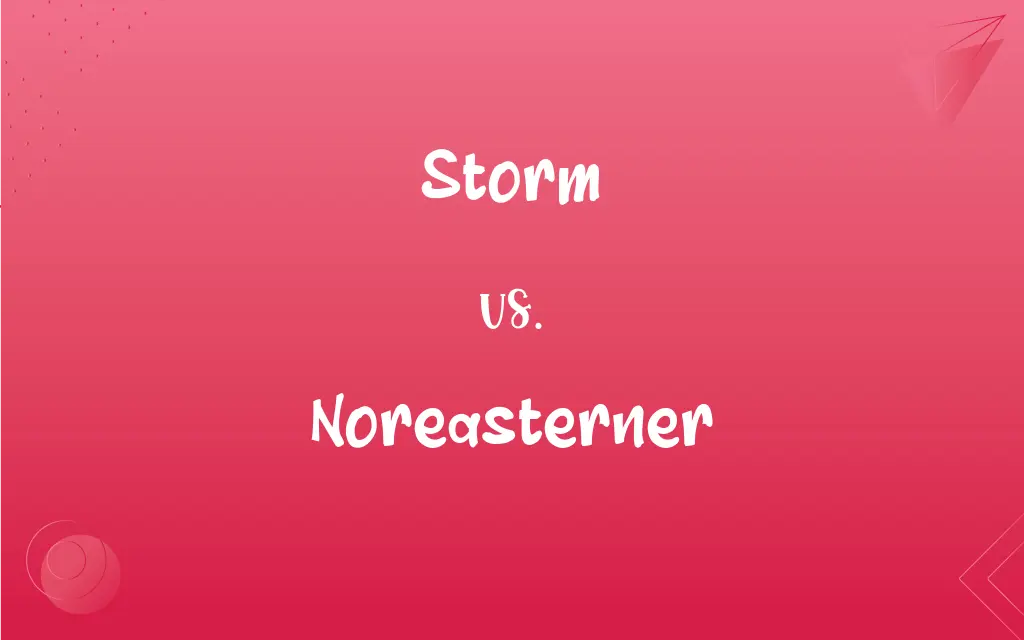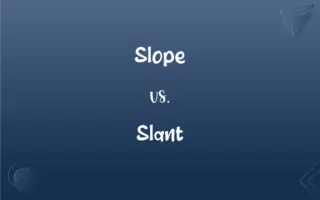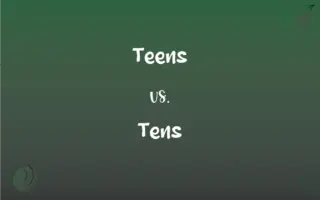Storm vs. Noreasterner: What's the Difference?
Edited by Aimie Carlson || By Janet White || Updated on November 18, 2023
A storm is a general term for any disturbed state of the atmosphere, often with rain, snow, or wind, while a nor'easter is a specific type of storm with strong winds from the northeast, typically affecting the East Coast of the United States.

Key Differences
A storm is a broad meteorological term referring to any significant atmospheric disturbance characterized by strong winds, rain, thunder, lightning, or snow. A nor'easter, on the other hand, is a specific type of storm noted for its intense winds blowing from the northeast.
Storms can occur anywhere in the world and take various forms, including thunderstorms, blizzards, and hurricanes. Nor'easters are specific to the North American east coast, bringing heavy rain or snow, rough seas, and potentially coastal flooding.
The formation of a storm depends on a variety of atmospheric conditions, such as temperature differentials and moisture availability. Nor'easters typically form within 100 miles east or west of the East Coast, driven by cold air masses from Canada colliding with warmer oceanic air.
Storm severity can range from mild to catastrophic, impacting small areas or large regions. Nor'easters are notorious for their potential to cause severe and widespread impacts, particularly in the winter months.
While storms are a common and expected part of weather systems globally, nor'easters are more geographically and seasonally specific, with a distinct pattern and set of characteristics that set them apart from other storm types.
ADVERTISEMENT
Comparison Chart
Definition
A disturbance in the atmosphere.
A storm with strong northeast winds.
Geographic Occurrence
Worldwide.
North American East Coast.
Seasonal Occurrence
Can occur in any season.
Mostly in late fall, winter, and early spring.
Typical Characteristics
Varies (rain, wind, snow, etc.).
Heavy rain or snow, strong winds, coastal impacts.
Impact Scale
Can vary from local to widespread.
Often widespread, particularly in coastal areas.
ADVERTISEMENT
Storm and Noreasterner Definitions
Storm
A violent disturbance of the atmosphere.
The storm brought heavy rain and thunder.
Noreasterner
A winter storm in the North Atlantic.
The nor'easter brought heavy snowfall to the region.
Storm
A tumultuous reaction; an uproar.
His resignation caused a political storm.
Noreasterner
A storm or wind blowing from the northeast.
The nor'easter caused widespread power outages.
Storm
A direct assault by troops.
The soldiers prepared to storm the enemy base.
Noreasterner
A storm typically affecting the northeastern U.S.
The nor'easter disrupted travel across the East Coast.
Storm
A heavy onslaught or attack.
The army's storm of the fortress was relentless.
Noreasterner
A storm with characteristics of a hurricane.
The nor'easter had hurricane-like conditions.
Storm
A severe disturbance of one's mental or emotional state.
After the news, she was in a personal storm of grief.
Noreasterner
A coastal storm with intense winds.
The approaching nor'easter prompted evacuations.
Storm
An atmospheric disturbance manifested in strong winds accompanied by rain, snow, or other precipitation and often by thunder and lightning.
Noreasterner
A native or inhabitant of the north-east of the USA
Storm
A wind with a speed from 48 to 55 knots (55 to 63 miles per hour; 89 to 102 kilometers per hour), according to the Beaufort scale. Also called whole gale.
Noreasterner
A severe winter storm where the winds blow from the northeast.
Storm
A heavy shower of objects, such as bullets or missiles.
FAQs
Are all storms dangerous?
The danger level varies; some storms are mild, while others can be catastrophic.
Can storms be predicted?
Yes, meteorologists use technology to predict storms and their paths.
What is a nor'easter?
A nor'easter is a storm with strong northeast winds, affecting the U.S. East Coast.
Do nor'easters affect only the U.S.?
Primarily, but they can also impact parts of Canada.
What is the main feature of a storm?
The main feature varies, including wind, rain, snow, or thunder.
Are nor'easters seasonal?
Yes, they mainly occur in late fall, winter, and early spring.
What is the most dangerous aspect of a nor'easter?
The combination of strong winds, heavy precipitation, and coastal impact is most dangerous.
What is a storm?
A storm is a significant disturbance in the atmosphere with strong winds and usually rain, snow, or thunder.
What causes a storm?
Storms are caused by atmospheric changes, including temperature differences and moisture.
Can nor'easters cause snow?
Yes, nor'easters can bring heavy snow, especially in winter.
Can we prevent storms?
No, but we can prepare and mitigate their impacts.
How does a nor'easter form?
Nor'easters form from cold air masses from Canada meeting warm ocean air.
Can nor'easters cause flooding?
Yes, especially in coastal areas due to storm surges and heavy rain.
Are storms named like hurricanes?
Generally, only specific types like hurricanes are named.
How long do nor'easters last?
They can last from a few hours to several days.
Can storms occur in deserts?
Yes, deserts can experience storms, though usually with less rain.
Do storms affect air travel?
Yes, storms can lead to flight delays and cancellations.
Is climate change affecting storms and nor'easters?
Yes, climate change is influencing the frequency and intensity of these events.
Are nor'easters predictable?
Yes, meteorologists use models to predict their development and track.
Do storms always bring rain?
Not always; some storms may bring snow, hail, or just winds.
About Author
Written by
Janet WhiteJanet White has been an esteemed writer and blogger for Difference Wiki. Holding a Master's degree in Science and Medical Journalism from the prestigious Boston University, she has consistently demonstrated her expertise and passion for her field. When she's not immersed in her work, Janet relishes her time exercising, delving into a good book, and cherishing moments with friends and family.
Edited by
Aimie CarlsonAimie Carlson, holding a master's degree in English literature, is a fervent English language enthusiast. She lends her writing talents to Difference Wiki, a prominent website that specializes in comparisons, offering readers insightful analyses that both captivate and inform.
































































